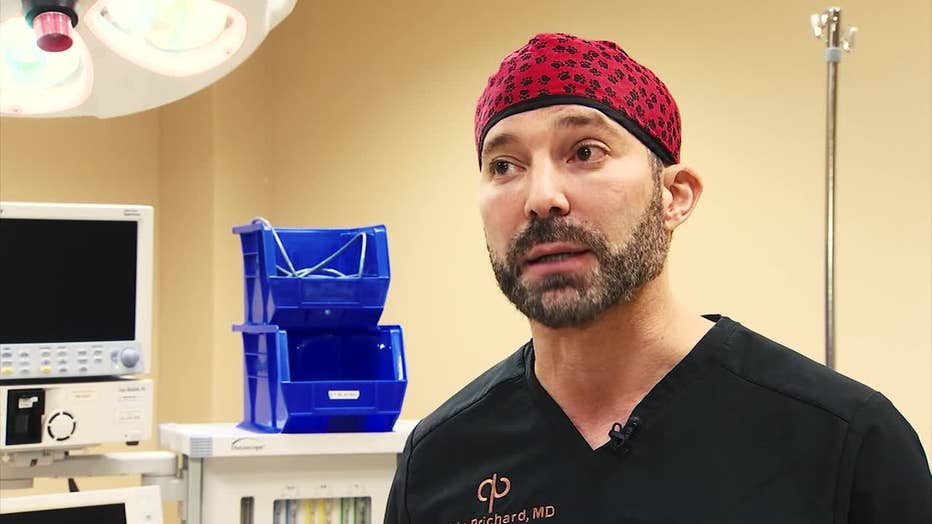People concerned about chemicals in sunscreen as they seek alternatives

PHOENIX - Even in the dead of winter, the Arizona sun is fierce.
"We try to stay out of the sun, especially in summertime, at peak times, when UV rays are at the highest," said Tiina Woullet.
Some would layer on the sunscreen in order to avoid sunburns at all cost, but just how safe is all that sunscreen?
"There's always cause to be concerned. There's so many things that cause cancers these days," said Dr. Pablo Prichard, Co Founder of Vincere Cancer Center.
Dr. Prichard says his patients ask about the chemicals in sunscreen all the time.
"They always want to know what is your recommendation on sun blocks," said Dr. Prichard.
Especially now, as the Food and Drug Administration (FDA) revealed new findings this year that show our bodies absorbing a lot more of the chemicals in sunscreen than they originally thought.
Six chemicals -- namely avobenzone, oxybenzone, octocrylene, homosalate, octisalate, and octinoxate -- are in most of the over-the-counter lotions, and can be absorbed through the skin after just one application.
"Some of these chemical blockers go into your bloodstream and stick around for 21 days after application, and there in much higher concentration in your bloodstream than the FDA originally thought," said Dr. Prichard.

Pablo Prichard, Co-Founder of the Vincere Cancer Center
FDA officials stress their results do not mean the six chemicals are unsafe in your bloodstream, or harmful in any way. but they say more research is needed now.
"You can't just say 'well I'm worried about my sunblock, so I'm not going to use sunblock.' That's the wrong answer too. So you want to use sunblock that maybe doesn't have those chemicals in it," said Dr. Prichard.
Dr. Prichard is referring to sunscreens with zinc or titanium dioxide. These sunscreens are mineral-based. They don't absorb into the skin, but stay on the skin and reflect the sun instead. Historically, mineral-based sunscreens are known to leave a white residue on the skin, thus making people look like Jeff Spicoli in Fast Times at Ridgemont High.
Times have changed, however, as Dr. Prichard says it's not like that anymore.
"You don't really see the white anymore. You can rub it in really good and it looks pretty transparent. So it's kind of clear, but you're still getting the same effectiveness,"
Dr. Prichard says there's something else to keep in mind for those putting on sunscreen: not enough people put on enough sunscreen. In fact, Dr. Prichard says people need a full shot glass full of sunscreen to cover the whole body.

"There's certainly no reason for alarm, and perhaps no reason for much concern yet," said Dr. Ferran Garcia-Pichel, Director of the Arizona State University Biodesign Center for Microbiomics.
Dr. Garcia-Pichel studies microbiomics at ASU, and says the microbes in dirt from a desert nearby creates its own sunscreen to protect itself from UV rays.
"To be able to thrive in the desert in the Arizona sunlight, even the microbes put a lot of effort into sunscreen, so shouldn't we?" said Dr. Garcia-Pichel.
Dr. Garcia-Pichel says people should keep using sunscreen, but maybe wear more protective clothing, and consider switching to mineral sunscreens instead.
"There is no reason to change our habits in any way," said Dr. Garcia-Pichel. "Improve our habits? Sure."
Phoenix resident Susie Graff just recently switched to zinc sunscreen for her two kids.
"Read about it once, and thought better safe than sorry," said Graff.
Woullet said the same for her seven kids.
"I'm very worried about the toxicity of it, so I try to not put it on my kids unless it's very necessary," said Woullet.
"It's an investment in your body though. You think about your car. What do you put on your car? Bathing your car? This is your body though. You only get one of those," said Dr. Prichard.
Online: https://www.drprichard.com

